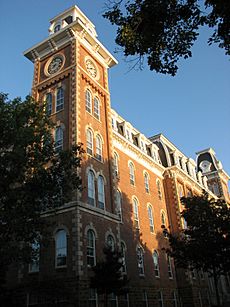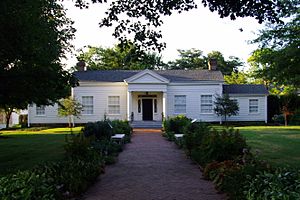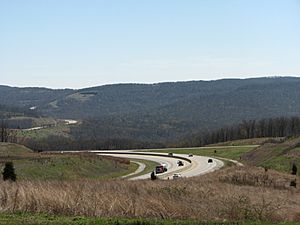Washington County, Arkansas facts for kids
Quick facts for kids
Washington County
|
|||
|---|---|---|---|
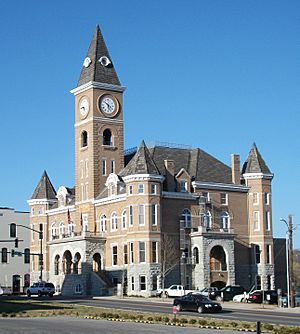
|
|||
|
|||

Location within the U.S. state of Arkansas
|
|||
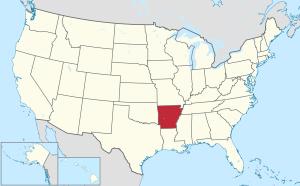 Arkansas's location within the U.S. |
|||
| Country | |||
| State | |||
| Founded | October 17, 1828 | ||
| Named for | George Washington | ||
| Seat | Fayetteville | ||
| Largest city | Fayetteville | ||
| Area | |||
| • Total | 951.72 sq mi (2,464.9 km2) | ||
| • Land | 945.43 sq mi (2,448.7 km2) | ||
| • Water | 6.29 sq mi (16.3 km2) 0.6%% | ||
| Population
(2020)
|
|||
| • Total | 245,871 | ||
| • Estimate
(2023)
|
261,549 |
||
| • Density | 258.3438/sq mi (99.7471/km2) | ||
| Time zone | UTC−6 (Central) | ||
| • Summer (DST) | UTC−5 (CDT) | ||
| ZIP Codes |
72701, 72703, 72704, 72717, 72727, 72729, 72730, 72738, 72744, 72749, 72753, 72761, 72762, 72764, 72769, 72773, 72774, 72959
|
||
| Area code | 479 | ||
| Congressional district | 3rd | ||
Washington County is a regional economic, educational, and cultural hub in the Northwest Arkansas region. Created as Arkansas's 17th county on November 30, 1848, Washington County has 13 incorporated municipalities, including Fayetteville, the county seat, and Springdale. The county is also the site of small towns, bedroom communities, and unincorporated places. The county is named for George Washington, the first President of the United States. Located within the Ozark Mountains, the county is roughly divided into two halves: the rolling Springfield Plateau in the more populous north of the county and the steeper, forested Boston Mountains in the much less populated south. It contains three segments of the Ozark National Forest, two state parks, two Wildlife Management Areas, the Garrett Hollow Natural Area, and dozens of city parks. Other historical features such as Civil War battlefields, log cabins, one-room school houses, community centers, and museums describe the history and culture of Washington County. Washington County occupies 951.72 square miles (243,220 ha) and contained a population of 245,871 people in 89,249 households as of the 2020 Census, ranking it 4th in size and 3rd in population among the state's 75 counties. The economy is largely based on the business/management, education, sales, office/administration, and poultry production industries. Poverty rates, median household income, and unemployment rates best state averages, but lag national trends. Washington County has long had a reputation for education in the state. The University of Arkansas, the largest four-year college in the state, was established in Fayetteville in 1871. A Washington County campus of the Northwest Arkansas Community College was opened in 2019 in Springdale. Today, Washington County contains eight public school districts, including two of the largest districts in the state (Springdale Public Schools and Fayetteville Public Schools) and two private schools. It is included in the Fayetteville–Springdale–Rogers Metropolitan Statistical Area.
Contents
History
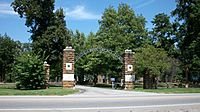
Washington County began as part of the Cherokee Territory, following an 1817 treaty. The area was next known as Lovely County, and one year later Washington County was created after another Cherokee treaty. The court house was centrally located in the city of Washington, modern-day Fayetteville (renamed to avoid confusion with Washington, Arkansas in South Arkansas). The Lee Creek Valley in southern Washington County contained many of the county's early settlements, including Cane Hill and Evansville.
Arkansas College and Cane Hill College were both founded in Washington County within a day of each other in 1834, with the University of Arkansas being founded in Fayetteville in 1871. The county witnessed major battles during the American Civil War, including the Battle of Fayetteville, the Battle of Prairie Grove, and the Battle of Cane Hill. The county then was sparsely settled and many residents were pro-Union, since slaves were few, plantations almost nonexistent, and news came via White River travelers, not from the southern part of the state. A Butterfield Overland Mail route was established through the county in 1858, causing more families to settle there.
The economy of Washington County was based on apples in the late 19th century. A mixture of wet weather, altitude, and loamy soils provided a good environment for apple orchards. First planted in areas around Lincoln, Evansville, and Cane Hill in the 1830s, apple orchards began all across the county. The United States Census reported a crop of 614,924 bushels of apples produced by the county in 1900, the highest in the state. Several varieties of apple were discovered in the area including Shannon Pippin, Wilson June, and most notably the Arkansas Black. The Ben Davis became the apple of choice in the area for sale and shipment across the region. Corn became the dominant crop, outselling apples by almost $500,000 in 1900.
Arkansas Industrial University was founded in the growing community of Fayetteville in 1871 after William McIlroy a donated farmland for the site. The university changed its name in 1899 to the University of Arkansas. Railroads came to Washington County after the St. Louis – San Francisco Railway (Frisco) decided to build a line to Texas through Fort Smith. Two possible routes were proposed, one passing through Prairie Grove, the other through Fayetteville. Many Fayetteville residents and farmers sold or donated land for the right of way to influence the choice. They were successful and in 1881 the first passenger train arrived at Fayetteville. The county continued to grow with more churches and schools after the railroad's completion. Rural parts of the county began losing population in the 1920s during the Great Depression, when high taxes forcing residents to move to Fayetteville or west to Oklahoma. The rural areas later became the Ozark National Forest and Devil's Den State Park.
Geography
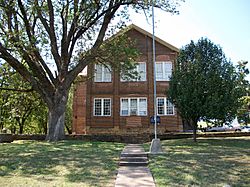
According to the U.S. Census Bureau, the county has a total area of 952 square miles (2,470 km2), of which 942 square miles (2,440 km2) is land and 10 square miles (26 km2) (1.1%) is water. It is the fourth-largest county by area in Arkansas. The county is in the Boston Mountains, a subdivision of the Ozark Mountains. Devil's Den State Park in southern Washington County is known for its picturesque views and mountain vistas. Washington County also contains Lake Wedington, located in scenic country west of Fayetteville on Wedington Drive.
Geology
Washington County sits on a basement of Precambrian granite and rhyolite, as most of the continental interior of the United States does. Much of the county's geologic history must be inferred from nearby Oklahoma and Missouri research, due to the steepness of the more recently formed mountains that did not form in the neighboring states. This igneous material was eroded until the Paleozoic, when oceans covered the now-low-lying area. These oceans came and retreated for 300 million years, depositing various different sedements during that time. This created fossiliferous limestone and ripple marked-sandstone, both present throughout the north part of the county as evidence of ancient oceans.
Sediments were deposited from the Devonian, Mississippian, and Pennsylvanian periods. During this deposition period, the county had a climate similar to that of the present-day Bahamas, as the equator was north of Washington County. The Devonian brought mostly shales, the Mississippian brought the limestones and chert visible in the bluffs. This chert is present throughout most of the county. The county is also home to the Boone Formation (red soils), white limestones, the Wedington Sandstone, the Bastesville Sandstone, the Pitkin formation (ocean-fossil limestone), and the Fayetteville Shale.
Settlers were attracted to the area by its numerous streams, used to power gristmills, sandstones and clays for use in construction, lime-sweetened soil, and chert for road construction.
Today, Washington County consists of two main formations, the Boston Mountains and the Springfield Plateau. During the late Pennsylvanian, sediments were deposited on top of the Springfield Plateau. The area was uplifted during the Ouachita orogeny and subsequent erosion formed the rugged Boston Mountains. Erosion of these sediments causes the Boston Mountains to be carved steeply in the south, while in the north of the county, the Boston Mountain sediments are almost entirely eroded, exposing the older rocks of the Springfield Plateau.
Adjacent counties
- Benton County (north)
- Madison County (east)
- Crawford County (south)
- Adair County, Oklahoma (west)
National protected area
- Ozark National Forest (part)
Demographics
| Historical population | |||
|---|---|---|---|
| Census | Pop. | %± | |
| 1830 | 2,182 | — | |
| 1840 | 7,148 | 227.6% | |
| 1850 | 9,970 | 39.5% | |
| 1860 | 14,673 | 47.2% | |
| 1870 | 17,266 | 17.7% | |
| 1880 | 23,844 | 38.1% | |
| 1890 | 32,024 | 34.3% | |
| 1900 | 34,256 | 7.0% | |
| 1910 | 33,889 | −1.1% | |
| 1920 | 35,468 | 4.7% | |
| 1930 | 39,255 | 10.7% | |
| 1940 | 41,114 | 4.7% | |
| 1950 | 49,979 | 21.6% | |
| 1960 | 55,797 | 11.6% | |
| 1970 | 77,370 | 38.7% | |
| 1980 | 100,494 | 29.9% | |
| 1990 | 113,409 | 12.9% | |
| 2000 | 157,715 | 39.1% | |
| 2010 | 203,065 | 28.8% | |
| 2020 | 245,871 | 21.1% | |
| 2023 (est.) | 261,549 | 28.8% | |
| U.S. Decennial Census 1790–1960 1900–1990 1990–2000 2010–2019 2020 |
|||
| Race / Ethnicity (NH = Non-Hispanic) | Pop 2000 | Pop 2010 | Pop 2020 | % 2000 | % 2010 | % 2020 |
|---|---|---|---|---|---|---|
| White alone (NH) | 133,368 | 150,546 | 160,566 | 84.56% | 74.14% | 65.30% |
| Black or African American alone (NH) | 3,408 | 5,828 | 8,330 | 2.16% | 2.87% | 3.39% |
| Native American or Alaska Native alone (NH) | 1,839 | 2,154 | 2,443 | 1.17% | 1.06% | 0.99% |
| Asian alone (NH) | 2,396 | 4,372 | 5,631 | 1.52% | 2.15% | 2.29% |
| Pacific Islander or Native Hawaiian alone (NH) | 820 | 4,100 | 8,734 | 0.52% | 2.02% | 3.55% |
| Other race alone (NH) | 114 | 227 | 729 | 0.07% | 0.11% | 0.30% |
| Mixed race or Multiracial (NH) | 2,838 | 4,380 | 14,683 | 1.80% | 2.16% | 5.97% |
| Hispanic or Latino (any race) | 12,932 | 31,458 | 44,755 | 8.20% | 15.49% | 18.20% |
| Total | 157,715 | 203,065 | 245,871 | 100.00% | 100.00% | 100.00% |
2020 Census
| Race | Number | Percentage |
|---|---|---|
| White (non-Hispanic) | 160,566 | 65.3% |
| Black or African American (non-Hispanic) | 8,330 | 3.39% |
| Native American | 2,443 | 0.99% |
| Asian | 5,631 | 2.29% |
| Pacific Islander | 8,734 | 3.55% |
| Other/Mixed | 15,412 | 6.27% |
| Hispanic or Latino | 44,755 | 18.2% |
As of the 2020 United States census, there were 245,871 people, 89,249 households, and 56,596 families residing in the county.
2010 Census
Racial/Ethnic Makeup of Washington County treating Hispanics as a Separate Category (2010) White Non-Hispanic (74.1%) Black Non-Hispanic (2.9%) Native American Non-Hispanic (1.1%) Asian Non-Hispanic (2.2%) Pacific Islander Non-Hispanic (2.0%) Other Non-Hispanic (0.1%) Two or more races Non-Hispanic (2.2%) Hispanic Any Race (15.5%)
As of the 2010 United States Census, there were 203,065 people, 76,389 households, and 48,059 families residing in the county. The population density was 213 people per square mile (82/km2). There were 87,808 housing units at an average density of 92 per square mile (36/km2). The racial makeup of the county was 79.9% White, 3.0% Black or African American, 1.2% Native American, 2.2% Asian, 2.0% Pacific Islander, 8.9% from other races, and 2.8% from two or more races. 15.5% of the population were Hispanic or Latino of any race.
There were 76,389 households, out of which 30.9% had children under the age of 18 living with them, 47.4% were married couples living together, 10.6% had a female householder with no husband present, and 37.1% were non-families. 27.5% of all households were made up of individuals, and 6.9% had someone living alone who was 65 years of age or older. The average household size was 2.56 and the average family size was 3.18.
In the county, the population was spread out, with 25.4% under the age of 18, 14.9% from 18 to 24, 28.5% from 25 to 44, 21.5% from 45 to 64, and 9.7% who were 65 years of age or older. The median age was 30.7 years. For every 100 females, there were 99.9 males. For every 100 females age 18 and over, there were 98.1 males.
The median income for a household in the county was $42,303, and the median income for a family was $52,300. Males had a median income of $37,430 versus $28,990 for females. The per capita income for the county was $22,421. About 12.1% of families and 17.9% of the population were below the poverty line, including 23.5% of those under age 18 and 9.5% of those age 65 or over.
2023 American Community Survey 5-Year Estimates
The United States Census Bureau also conducts estimated annual counts based on sampling for all jurisdictions. Due to the margin of error, it is not directly comparable to the decennial census.
|
Racial Makeup of Washington County, Arkansas (2023) White alone (67.22%) Black alone (3.18%) Native American alone (1.04%) Asian alone (2.40%) Pacific Islander alone (2.71%) Other race (5.47%) Multiracial (17.97%) |
Racial Makeup of Washington County, Arkansas treating Hispanics as a Racial Category (2023) |
Racial Makeup of Hispanics in Washington County, Arkansas (2023) White alone (24.51%) Black alone (0.23%) Native American alone (2.92%) Asian alone (0.29%) Pacific Islander alone (0.01%) Other race alone (27.81%) Multiracial (44.23%) |
Human resources
Education
Washington County has historically been known as a center for education in Arkansas. Cane Hill College in Canehill was the first college in Arkansas, prior to the University of Arkansas's founding in 1871.
A 2012 study found 84.2% of Washington County residents over age 25 held a high school degree or higher and 31.9% held a bachelor's degree or higher. The Washington County high school rates are similar to state and national averages of 84.8% and 86.7%, respectively. The bachelor's degree rate is the second-highest of any county in Arkansas (statewide average of 21.1%, only behind Pulaski County's 33.7%), but only slightly above the national averages of 29.8%.
Primary and secondary education
School districts include:
- Elkins School District
- Farmington School District
- Fayetteville School District
- Greenland Public Schools
- Lincoln School District
- Prairie Grove School District
- Siloam Springs Schools
- Springdale School District
- West Fork School District
Private schools:
- Haas Hall Academy
- Ozark Montessori Academy Springdale
Higher education
The University of Arkansas at Fayetteville was founded in 1871 on the site of a hilltop farm that overlooked the Ozark Mountains, giving it the nickname "The Hill". It is the largest institution of higher learning in the state, with a fall 2019 undergraduate enrollment of 23,025 making UA three times larger than the next-largest institutions. Of the six undergraduate academic units, the largest is J. William Fulbright College of Arts and Sciences, followed by the Sam M. Walton College of Business and the College of Education and Health Professions. Enrollment increased 50% following the Campaign for the 21st Century, with much of the growth coming from out-of-state students. As a result, out-of-state students have a significant influence on the Washington County demographics and economy.
The Northwest Arkansas Community College opened a campus in Springdale in 2019.
Library system
Washington County is home to the Fayetteville Public Library and the Washington County Library System (WCLS). The WCLS consists of eight branch libraries, including the Springdale Public Library and seven branches in smaller cities across the county. The libraries offers books, e-books, media, reference, youth, business and genealogy services.
Culture and contemporary life
Washington County has several facilities, monuments, and museums dedicated to preserving the history and culture of the area. The Washington County Historical Museum, owned and operated by the Washington County Historical Society, preserves and interprets the history and culture of Washington County for visitors and residents. Regional history is maintained and taught through the Shiloh Museum of Ozark History in Springdale since 1968. The Clinton House Museum in Fayetteville is a historic house museum dedicated to the lives of Bill Clinton and Hillary Rodham while they both taught at the University of Arkansas School of Law and was where they married in 1975.
Over 100 properties are listed on the National Register of Historic Places in Washington County, ranging from historic districts (UA Campus, Washington-Willow, Dickson Street, Mock Street, Springdale Poultry Industry and others) to Civil War battlefields (Cane Hill Battlefield and Prairie Grove Battlefield Park), historic homes of area leaders (Gregg House, Stone House), community gathering places (Mineral Springs Community Building), and places of worship (Shiloh Church, United Presbyterian Church of Canehill).
Annual cultural events
Many cultural events take place in Washington County annually. Some of the largest include:
- Arkansas Razorbacks football games in fall, estimated to bring 156,765 visitors from outside Northwest Arkansas in 2018
- Walmart Shareholder's Meeting at Bud Walton Arena brings over 5,000 employees to Fayetteville from around the world.
- Bikes, Blues, & BBQ motorcycle rally on Dickson Street in Fayetteville with over 400,000 people attending over four days
- Roots Fest, annual five-day music and food festival in Fayetteville
- Battle of Prairie Grove Reenactment, hundreds of Civil War reenactors camp and fight at Prairie Grove Battlefield State Park in December of even-numbered years
- NWA Pride, the largest LGBTQ+ Pride event in the state held in Fayetteville every June.
Communities
Cities
Towns
Unincorporated communities
Townships
Townships in Arkansas are the divisions of a county. Each township includes unincorporated areas and some may have incorporated towns or cities within part of their space. Townships have limited purposes in modern times. However, they are of value for historical purposes in terms of genealogical research. Each town or city is within one or more townships in an Arkansas county based on census maps. The townships of Washington County are listed below. In Washington County, each incorporated town/city is at least partially located within its namesake township.
- Boston
- Brush Creek
- Cane Hill
- Center
- Cove Creek
- Crawford
- Durham
- Dutch Mills
- Elkins (Elkins)
- Elm Springs (Elm Springs)
- Farmington (Farmington)
- Fayetteville (Fayetteville)
- Goshen (Goshen)
- Greenland (Greenland)
- Harmon
- Illinois
- Johnson (Johnson)
- Lee's Creek
- Lincoln (Lincoln)
- Litteral
- Marrs Hill
- Morrow
- Prairie
- Prairie Grove (Prairie Grove)
- Reed
- Rhea's Mill
- Richland
- Springdale (most of Springdale)
- Starr Hill
- Tontitown (Tontitown)
- Valley
- Vineyard
- Wedington
- West Fork (West Fork)
- White River
- Winslow (Winslow)
- Wyman
Infrastructure
Major highways
Washington County has contained the Ozark Trail, Trail of Tears, and the Butterfield Overland Mail route. Today, Interstate 49 serves as the county's main thoroughfare, and connects the University of Arkansas with Fort Smith and Interstate 40 to the south and other NWA cities to the north. Future plans call for Interstate 49 to be extended to ultimately connect New Orleans, Louisiana with Kansas City, Missouri through Washington County.
 Interstate 49
Interstate 49 U.S. Route 62
U.S. Route 62 U.S. Route 71
U.S. Route 71 U.S. Route 412
U.S. Route 412 U.S. Route 71B
U.S. Route 71B Highway 16
Highway 16 Highway 45
Highway 45 Highway 59
Highway 59 Highway 74
Highway 74 Highway 112
Highway 112 Highway 156
Highway 156 Highway 170
Highway 170 Highway 180
Highway 180 Highway 220
Highway 220 Highway 244
Highway 244 Highway 265
Highway 265 Highway 303
Highway 303
Transit
- Jefferson Lines
- Ozark Regional Transit
- Razorback Transit
Utilities
The Arkansas Department of Health is responsible for the regulation and oversight of public water systems throughout the state. Washington County contains twelve community water systems, including two of the largest distribution systems in the state: the City of Fayetteville (retail population served of 94,000) and Springdale Water Utilities (SWU, 87,618) Both water systems purchase all potable water from Beaver Water District. Many of the smaller cities in Washington County purchase water from Fayetteville, SWU, Benton-Washington Regional Public Water Authority (PWA, colloquially "Two-Ton") or Washington Water Authority (WWA), including Elkins, Lincoln, Tontitown, West Fork, and Winslow.
See also
 In Spanish: Condado de Washington (Arkansas) para niños
In Spanish: Condado de Washington (Arkansas) para niños





